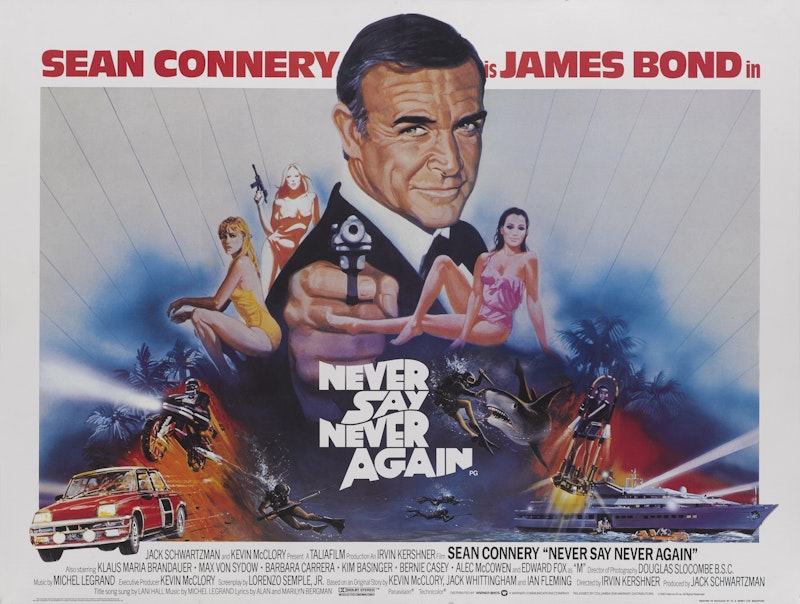In late-1983 Kevin McClory’s long legal battles finally paid off. Twenty-five years after collaborating with Ian Fleming on a story that eventually became the novel and film Thunderball, McClory’s own version of that story reached theaters under the title Never Say Never Again. He couldn’t use the material added to the Bond mythos by the Eon Productions films, such as the theme song, but could and did hire Sean Connery to reprise the role of James Bond.
It’s the first real remake of a Bond story to reach the big screen (leaving aside the non-Eon 1967 Casino Royale film, which followed a 1954 TV version of the same novel). And there’s a familiarity to the material, even though this isn’t an Eon film. Beyond the specifics of the plot, there’s a comfortable overall Bond feel to events.
After an unsatisfactory showing in a training exercise, MI6 agent 007 James Bond is assigned to a health spa for reconditioning. There he stumbles onto an operation of the criminal organization SPECTRE, who successfully steal two nuclear warheads. Bond’s assigned to locate and recover the warheads, and their trail takes him to the Bahamas and millionaire Maximillian Largo (Klaus Maria Brandauer). Bond and Largo test each other with a holographic video game, and Bond seduces Largo’s girlfriend Domino. Action scenes follow; Bond saves the world, and retires.
Irvin Kershner, fresh off The Empire Strikes Back, directs in a workmanlike way. This isn’t a colorful or dynamic film, but at least it’s more visually textured than the last couple of Eon Bond movies. The script, reworked over the years—at one point Len Deighton did a draft—is from Lorenzo Semple Jr., with uncredited rewrites from Dick Clement and Ian La Frenais at Connery’s behest.
There are a few changes from Thunderball. The opening training sequence is new, the spa scenes are more tightly integrated into the plot, and the climax is mostly new and more entertaining. The video-game sequence is an obvious 1980s touch, but on the whole the world of this film is more subdued than Thunderball. The 1960s mod spy-fi weirdness is almost gone.
But the presence of SPECTRE undermines any down-to-earth feel to the film, even if Max von Sydow gives an engaging version of Ernst Stavro Blofeld. In the 1960s SPECTRE became the template for all sorts of alphabet-soup spy organizations, good and bad. It feels out of place in the duller 80s, and it’s interesting to contrast SPECTRE here with the way the Marvel Cinematic Universe integrated SHIELD and Hydra with no apparent strain—when you have gods and super-soldiers running around, a couple of 1960s spy groups don’t stand out. Lacking that cover, Never Say Never Again has some occasional jarring moments.
At least the acting’s good. Connery was involved in the film’s production, and perhaps that’s why this is the closest a Bond film gets to an actor’s movie. Kim Basinger’s solid enough in her third film role, Rowan Atkinson in his feature film debut gets a nice turn as comic relief, Bernie Casey gives us maybe the most interesting Felix Leiter to appear on screen, Sydow is Sydow, and they’re almost all outshone by Barbara Carrera as the exuberant, lascivious Fatima Blush. Still, the real standout is the baby-faced Brandauer, who at first looks like anything but a super-villain and then takes every opportunity to deliver charismatic madness. There’s a reasonable argument that he’s the most compelling screen antagonist for Bond since Donald Pleasance back in You Only Live Twice.
Connery has a relaxed ease with a story he’s already played. There’s a lack of zest, but nothing like the resignation with which he went through the motions in Diamonds Are Forever. His performance fits this film, particularly the older Bond he’s playing. He’s content to underplay, allowing his co-stars to shine while building a wearier, more experienced Bond.
Scenes with Edward Fox’s Thatcherite M are effective, as Bond interacts with a superior much younger than him. It’s a clever idea, and it works, just as it’s interesting to see Bond dealing with a more supportive Q (Alec McCowen): “Now you're on this, I hope we're going to have some gratuitous sex and violence!” he tells Connery, cracking the fourth wall just enough.
The action is notably better than the Eon Bond movies, if only because Connery’s a bit younger than Roger Moore (though still 53 when the movie came out) and Kershner shoots around it better. A shirtless scene is still a bad idea, but humor’s on the whole well-integrated into the film. For better or worse, the movie doesn’t feel like it’s challenging or subverting the traditional Bond films at all. There’s a kind of ending for Bond, but this is essentially a solid straight-faced action movie that’s surprisingly content to play to standard formula rather than swing for the fences.
As such, the movie’s arguably more like Fleming’s novels than are the Eon films; ironic, given the legal issues between McClory and Fleming. But the movie also suggests what we’d have got if Connery hadn’t lost the taste for playing Bond and kept starring in the films into the 1980s. It’s better than most of Moore’s films, notably including Octopussy, released earlier in 1983. But it’s not better than Thunderball, even if it’s more evenly paced. It turns out that even when other people than the Eon Films crew make a Bond film in the 1980s, the swing of the 60s is still absent.

